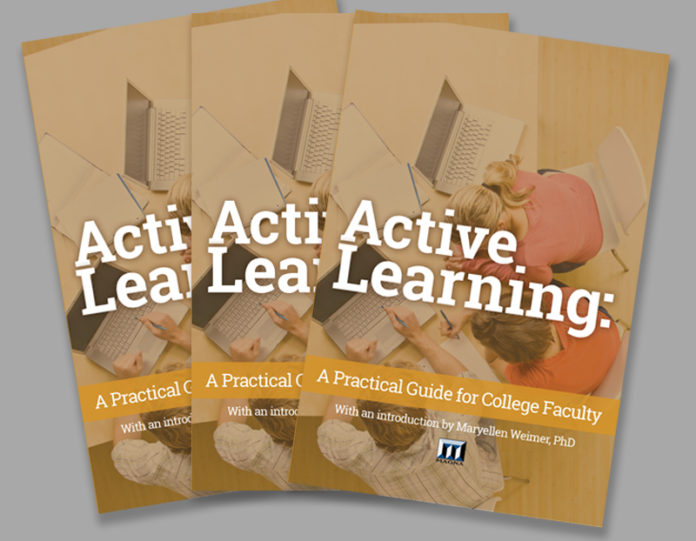Most of us think we know what active learning is. The word engagement quickly comes to mind. Or, we describe what it isn’t: passive learning. Definitions also abound, the one proposed by Bonwell and Eison in an early (and now classic) active learning monograph is widely referenced: involving “students in doing things and thinking about the things they are doing” (p. 2).
Those are fine places to start, but as interest in active learning has grown—and with its value now firmly established empirically—what gets labeled as active learning continues to expand. Carr, Palmer, and Hagel recently wrote, “Active learning is a very broad concept that covers or is associated with a wide variety of learning strategies” (p. 173). This may include experiential learning; learning by doing (hands-on learning); applied learning; service learning; peer teaching (in various contexts); lab work; role plays; case-based learning; group work of various kinds; technology-based strategies such as simulations, games, clickers, and various smart phone applications; and classroom interaction, with participation and discussion probably being the most widely used of all active learning approaches. Beyond strategies are theories such as constructivism that have spun off collections of student-centered approaches that promote student autonomy, self-direction, and self-regulation of learning.
What we next need to know about active learning won’t be all that easy to figure out, but it’s time we moved from generic understandings to the specific details.
Browse the following topics for resources, programs, seminars, free reports, and articles to help guide you in your active learning adventure:
Active Learning Strategies
Think-Pair-Share
Active Learning Classroom
Active Learning versus Passive Learning

Active Learning Strategies
Active learning can be an intimidating concept for educators. Many educators have heard the term but struggle to understand the true meaning of active learning and/or integrate active learning strategies within their classroom. Essentially, active learning involves including students in what they are learning, and fostering an environment that encourages them to think on these matters. Student involvement and metacognition, or thinking about thinking, are fundamental to one’s ability to understand active learning. The following articles and resources dive into active learning strategies for higher education and how you can start implementing them into your own course.
Free articles
- Active Learning That Distracts from Learning
- Three Active Learning Strategies That Push Students Beyond Memorization
- Three Active Learning Strategies You Can Do in 10 Minutes or Less
- Deeper Thinking about Active Learning
- Lecture vs. Active Learning: Reframing the Conversation
- Active Learning: In Need of Deeper Exploration
- More Evidence That Active Learning Trumps Lecturing
- Course Redesign Finds Right Blend of Content Delivery and Active Learning
- Active Learning: Changed Attitudes and Improved Performance
- Students Share Their Thoughts on Active Learning
- Implementing Active Learning and Student-Centered Pedagogy
Teaching Professor articles (requires paid subscription)
- Low-Risk Strategies to Promote Active Learning in Large Classes
- Active Learning: A Perspective from Cognitive Psychology
- Understanding Student Resistance to Active Learning
- Active Learning Wins
Related products

Think-Pair-Share
You may have already heard of the think-pair-share assessment. The think-pair-share classroom assessment technique asks students to take one minute and write a response to a question. Then asks students to share their thoughts with a classmate, and finally, has pairs of students share with the class as a whole. The following provides alternatives to think-pair-share assessments and provides ways on how your students will go from blank stares to true engagement by using this activity. This shift increases the likelihood that students will learn more and that faculty won’t encounter awkward silence when initiating a discussion.
Free articles
- Choosing the Best Approach for Small Group Work
- Cooperative Learning Structures and Deep Learning
- Class Discussion: From Blank Stares to True Engagement
- Five Ways to Engage Students in an Online Learning Environment
Teaching Professor articles (requires paid subscription)
Related products

Active Learning Classroom
A lot of us would wholeheartedly agree that active learning works. We have some familiarity with the research that supports it, and we’ve seen its positive effects in our classrooms. Done well, it engages students and overcomes the passivity that lectures regularly produce. John Dewey was right; students learn by doing better than by listening. The following explores definitions of active learning, its intensity, how it’s delivered, and how you can purposefully implement active learning into the classroom. Whether you’re planning to implement active learning into a large class, small class, or online course, we’ll explore active learning activities and active engagement in all aspects.
Free articles
- Active Learning: Surmounting the Challenges in a Large Class
- Keeping Introverts in Mind in Your Active Learning Classroom
- Active-Learning Ideas for Large Classes: Simple to Complex
Teaching Professor articles (requires paid subscription)
- Does Active Learning Work?
- Incorporating Active Learning into the Online Classroom
- Lecture or Active Learning? When to Decide
- An Active Learning Exploration: Two-Stage Exams
Related products

On-the-fly Assessment Strategies for the Active Learning Classroom 
Helping Introverts Thrive in an Active Learning Classroom 
Active Learning: A Practical Guide for College Faculty 
What 5 Play-based Activities Can I Use to Create an Active, Learning-centered Class? 
Engaging College Students Using Active Learning Techniques

Active Learning versus Passive Learning
Some students just don’t seem all that interested in learning. Most faculty work hard to help students find the missing motivation. They try a wide range of active learning strategies, and those approaches are successful with a lot of students but not all students. So how do you get students to go from passive learning to active learning without the dreaded resistance? Perhaps teachers can’t respond successfully unless they are knowledgeable about the sources of resistance to learning. Part of this is resistance for understandable reasons. Active learning means more work for students. They aren’t getting a neat, comprehensive package of teacher-generated examples, but are having to come up with their own. They aren’t watching the teacher solve all the problems, but are being put into groups to collectively work on the problems. Passive learning is easier than active learning, but then passivity doesn’t always result in learning, especially learning that lasts and knowledge that can be applied.
Free articles
- Putting Students in the Driver’s Seat: Technology Projects to Decrease Passivity
- Student Learning: Six Causes of Resistance
- From Passive Viewing to Active Learning: Simple Techniques for Applying Active Learning Strategies to Online Course Videos







